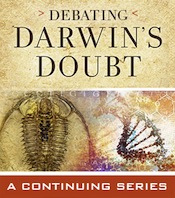 Evolution
Evolution
Hox Genes to the Rescue?

Hox gene clusters are regulatory elements that switch on genes downstream in embryological development. When you swap one cluster with another, what happens? Evolution?
Some Swiss scientists decided to have a little fun at the expense of some unfortunate mice. They swapped the order of action of the HoxC and HoxD regulatory clusters (two of four such clusters) to see what happens. Their paper in PNAS is titled "Reshuffling genomic landscapes to study the regulatory evolution of Hox gene clusters."
The emergence of Vertebrata was accompanied by two rounds of whole-genome duplications. This enabled paralogous genes to acquire novel functions with high evolutionary potential, a process suggested to occur mostly by changes in gene regulation, rather than in protein sequences. In the case of Hox gene clusters, such duplications favored the appearance of distinct global regulations…. Our results emphasize the importance of evolving regulatory modules rather than their target genes in the process of neo-functionalization and offer a genetic tool to study the complexity of the vertebrate regulatory genome. (Emphasis added.)
So what happened? Well, they got mice with deformed digits. Some of the digits could be rescued by expression of "paralogous genes" from the other cluster. In short, they got various degrees of deformed feet.
The explanation relies on their assertion that "the emergence of Vertebrata was accompanied by two rounds of whole-gene duplications." For that, they pass the ball to Susumi Ohno’s paper from 1970 about evolution by gene duplication, and a more recent paper from 2005 claiming there were two such rounds. According to the story, when a gene duplicates, one copy keeps working and the other can evolve. The evolving copy might discover "neo-functionalization" – some new function by unguided processes that get lucky, since they now have "high evolutionary potential."
When neo-functionalization occurs in regulatory genes, like Hox genes, major changes in phenotype might occur without changes to the protein sequences. Does this really happen? To assess that, consider how many hedging words they use:
- Duplicated genes could thus acquire novel functions distinct from their ancestral roles during vertebrate evolution.
- This process could have involved modifications of coding sequences, albeit constrained by the original protein structure.
- …slight modifications in transcriptional regulation, for example, through alterations in cluster architecture or enhancer activities, could have modulated the phenotype and thus participated in the morphological diversification of digits.
- Clearly, Hoxc genes could theoretically have been recruited during the emergence of tetrapod digits, instead of the HoxD cluster.
- The spatially restricted restoration functionally demonstrates the local and direct effect of HOX protein levels on the morphogenesis of individual digits via their impact upon the stimulation of primary ossification. This, added to the dose-dependent effects of various paralogous Hox groups on digit morphologies, may provide part of the explanation of the amazing range of variations observed in tetrapod distal limb skeletons.
- Although this structural diversity in itself has important implications for the transcriptional regulation of the resident genes, the topology of the gene cluster may in turn be modified and consolidated through the appearance of novel regulatory controls.
- Our work also suggests that any group 12 or 13 HOX protein may contribute to these processes, thus increasing the realm of possibilities for morphological variation to occur.
- The recurrent deployment of global regulatory elements at vertebrate Hox loci might thus have contributed to their exceptionally tight organization.
They must be talking about Mighty Mouse, because he "might" have evolved from random shuffling of his Hox genes. Is this credible?
Hox Shocks
 Stephen Meyer discussed Hox genes in Chapter 16 of Darwin’s Doubt (pp. 317-321), along with all the other proposals for rescuing neo-Darwinism from the problems of the Cambrian explosion: specifically, the origin of all the complex specified information necessary to generate new body plans.
Stephen Meyer discussed Hox genes in Chapter 16 of Darwin’s Doubt (pp. 317-321), along with all the other proposals for rescuing neo-Darwinism from the problems of the Cambrian explosion: specifically, the origin of all the complex specified information necessary to generate new body plans.
Meyer points out that since Hox genes coordinate the expression of so many other different genes, experiments have shown that mutations are harmful. That happened here; the mice were deformed. None of them got better, even if swapping the order of some of the Hox gene clusters "rescued" the phenotype from complete failure. A second problem is that Hox genes are expressed after the beginning of animal development, when the basic body axes are already in place. A third problem is that Hox genes only switch other genes on and off. As such, they cannot be sources of genetic information required to build new body plans.
Duplicate Disasters
Meyer also discusses gene duplication in Chapter 11 (see Fig. 11.2, p. 214). As with other proposals, this answer begs the question of the origin of genetic information. It cannot serve as a mechanism for searching the vast sequence space to find function. When dealing with unguided processes, like neo-Darwinism, no strategy is any better than blind search. In the imaginations of Darwinists it "could" or "might" or "may" or "possibly" happen — but the probabilities are against them. In Chapter 10, Meyer reviews the work of Doug Axe who, with generous assumptions to facilitate evolution, calculated vanishingly small chances of finding functional protein sequences in the search space of possible ones. No amount of duplicating existing genes or switching them on or off with Hox genes can overcome the low probability of success.
This new paper, like the ones preceding it, dodges the important question of the origin of genetic information. It presumes that duplicating a gene or a gene cluster can produce new body plans, new organs, and new organisms — sorry, duplicating garbage only gives you twice as much garbage. It presumes that switching on downstream genes will do the trick — sorry, switches can only switch on what already exists.
With cocky presumptuousness, the authors speak of "the emergence of morphological novelties," "the emergence of Vertebrata," and "the appearance of novel regulatory controls," without providing a mechanism other than blind search to achieve such miraculous manifestations. In fact, the only cause known to man capable of achieving the hierarchical organization seen in life, with its immense store of complex specified information, is intelligence.
Photo credit: Coast Guard News/Flickr.
